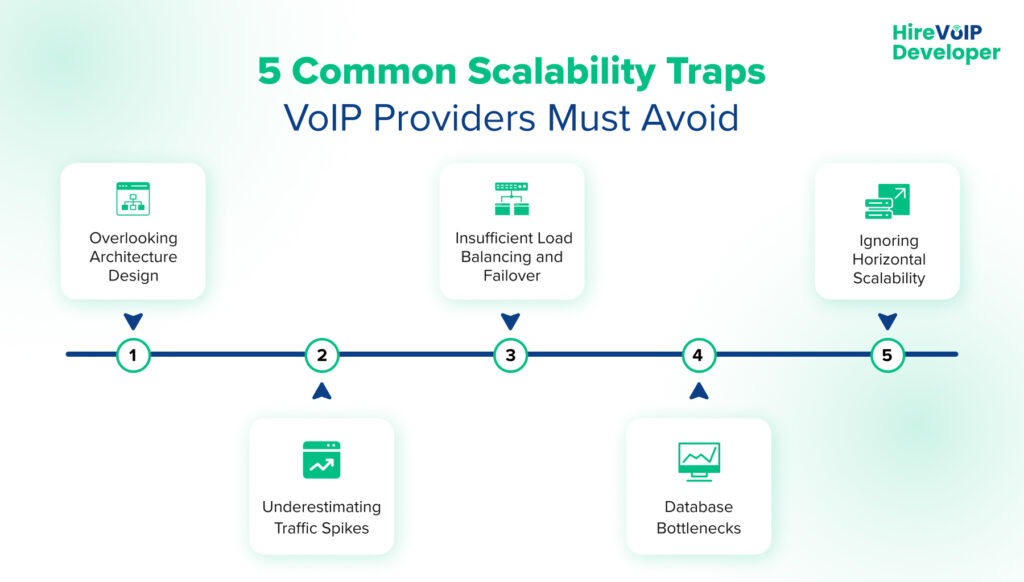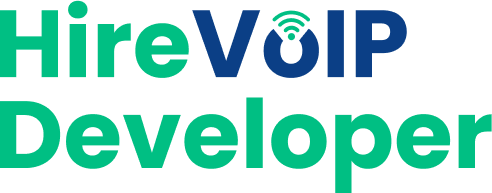📝 Blog Summary
- This blog uncovers 5 common scalability traps VoIP providers should watch out for!
- t highlights ways to prevent these issues as your system grows.
- It explains the importance of scalability in AI-enabled VoIP platforms.
Your VoIP platform is gaining traction, and customer numbers are doubling.
and suddenly!!!
calls start dropping, ⬇️
support tickets pile up, and 📈
Your team scrambles to fix what was supposed to be “scalable.”
And what went wrong here?
The architecture that once worked fine at a small user base simply can’t stretch to support the sudden surge in traffic, and cracks begin to show in the infrastructure, and performance collapses under pressure.
The demand for AI-driven VoIP solutions has increased significantly in recent years, with more enterprises switching to cloud-based communication for flexibility, lower costs, and global reach. But this rapid growth puts intense pressure on VoIP providers to scale quickly without sacrificing reliability, call quality, or uptime.
Why Scalability Matters in VoIP?
Scalability means your VoIP platform can grow without breaking.
It ensures your system delivers –
✅ consistent call quality,
✅ uptime, and
✅ performance
even as user numbers spike, protecting your reputation and revenue.
Let’s look at five common scalability traps and how to avoid them.
5 Common Scalability Traps VoIP Providers Must Avoid
Many providers focus on adding more servers, when real growth needs smarter architecture. Without the right strategies for VoIP scalability solutions, even the best systems can crumble under rising user demand.
To help you build stronger and scaling enterprise VoIP solutions, let’s explore the five common traps most providers fall into. Avoiding these early can save you from costly downtime and lost customers later.

1. Overlooking Architecture Design
- Many VoIP providers begin with a monolithic architecture that feels fast to launch but quickly becomes a liability as traffic grows.
- Because everything is tightly coupled, a single performance issue can ripple through the entire system.
- This kind of design limits flexibility, you can’t scale individual components like call routing or billing independently.
- As a result, when demand rises, the whole system slows down or crashes entirely.
The fix?
- Breaking your VoIP platform into smaller, independent services makes it easy to scale components on demand without disrupting the whole system.
- This approach not only improves performance but also future-proofs your system against unpredictable demand spikes.
- It’s one of the most impactful VoIP scalability solutions you can implement early on.
2. Underestimating Traffic Spikes
- Unexpected spikes in user traffic are one of the biggest hidden threats to VoIP systems.
- They often happen during product launches, marketing campaigns, or when onboarding new enterprise clients.
- If your system isn’t prepared, these surges can trigger call delays, dropped calls, and major outages.
- The damage to customer experience and brand trust can take months to recover from.
The fix?
- Run regular load and stress tests to understand your platform’s breaking points.
- Set up auto-scaling policies and monitoring systems that dynamically allocate resources when demand rises suddenly.
- By anticipating these bursts and having scalable capacity ready, you keep your users happy and your services uninterrupted.
- This is critical to scaling enterprise VoIP systems effectively and sustainably.
3. Insufficient Load Balancing and Failover
- Many providers rely on a single load balancer or single-region setup to handle user traffic.
- While simple, this creates a single point of failure that can bring your entire service down during outages or node failures.
- Even if your servers are powerful, one hardware or network glitch can trigger service-wide downtime and SLA breaches.
- The bigger your platform grows, the greater this risk becomes.
The fix?
- Use geo-distributed load balancers, redundant nodes, and automated failover strategies.
- Distribute traffic across multiple regions so that if one fails, traffic is instantly rerouted without disrupting users.
- This not only improves uptime but also reduces latency for global users.
- It’s one of the most reliable VoIP scalability solutions for long-term platform resilience.
4. Database Bottlenecks
- A centralized database might work for a small user base but can quickly become your biggest bottleneck as you scale.
- High call volumes generate massive amounts of data, and centralized systems struggle to process these loads in real time.
- Performance drops at the database level can ripple through your entire platform.
- Suddenly, call routing slows, analytics lag behind, and billing becomes inaccurate.
The fix?
- Adopt database sharding, replication, and distributed caching to spread the load across multiple servers.
- This ensures high availability and faster data access, even under heavy loads.
- Also invest in real-time call monitoring and automated alerts to detect issues before they hit your users.
- These strategies are vital for scaling enterprise VoIP systems without performance degradation.
5. Ignoring Horizontal Scalability
- Many VoIP providers assume scaling means buying bigger, more powerful servers.
- This vertical scaling works to a point, but it’s costly and risky, and it hits a ceiling quickly
- If that single big server goes down, your entire platform collapses
- And upgrading it again and again isn’t financially sustainable as your user base keeps growing.
The fix?
- Design your platform for horizontal scalability, where you can add more servers or nodes instead of just upgrading existing ones.
- This approach gives you flexibility, better cost control, and significantly higher resilience.
- It’s the model used by the world’s most scalable platforms and it’s essential to avoid the most common VoIP scalability challenges.
What’s Next for VoIP Solutions?
AI-driven VoIP is shaping the future by enhancing real-time communication and streamlining business interactions.
- Smarter call routing through AI
- Real-time language translation
- Predictive analytics for better decision-making
- Auto-scaling to handle growing user loads
Scalability ensures VoIP solutions can grow with your business without compromising performance.
Now that we’ve gone through the common scalability traps and how to avoid them, it’s clear AI-driven VoIP solutions are here to stay.
So, let’s wrap it up with a few key takeaways.
The Bottom Line?
Ignoring scalability isn’t just a technical flaw, it’s a business gamble.
Every dropped call or minute of downtime can erode your reputation, damage customer trust, and drain revenue streams you’ve worked hard to build.
The sooner you address VoIP scalability challenges, the more confidently you can expand your services and outpace competitors. By investing in robust VoIP scalability solutions early, you create a foundation strong enough to handle any growth curve.
🗝️ Key Takeaways:
- Build scalability into your VoIP architecture from the ground up.
- Prepare for traffic spikes, load balancing issues, and database limits before they hit.
- Use horizontal scaling and cloud-native design to power sustainable growth.
When you choose Hire VoIP developers experienced in scaling enterprise VoIP systems, you gain more than code, you gain a platform engineered to grow with your vision. We design and implement an infrastructure that stays resilient, adaptable, and future-ready, no matter how fast your business evolves.


